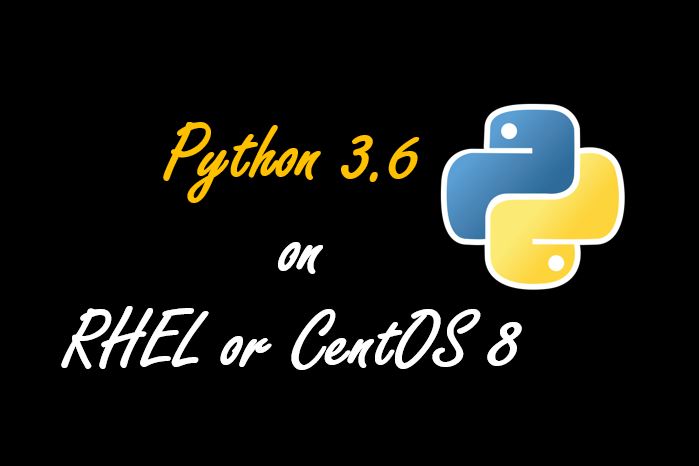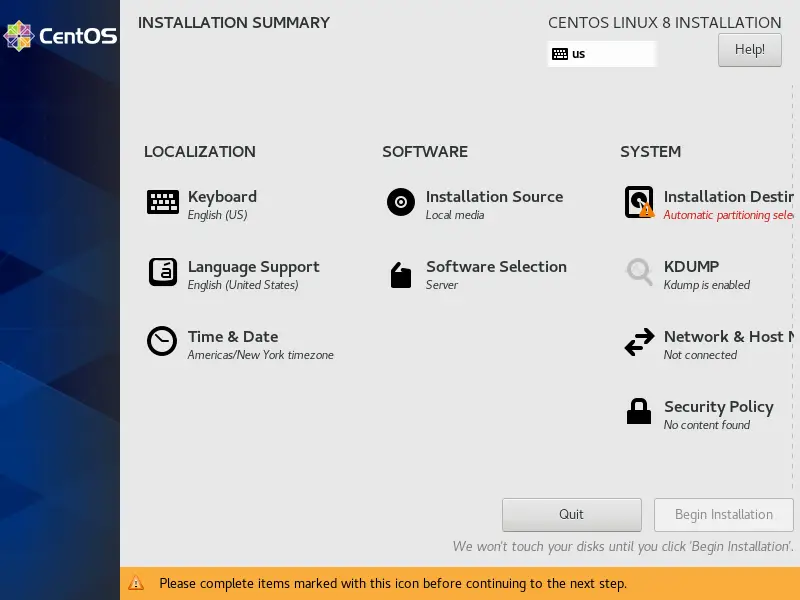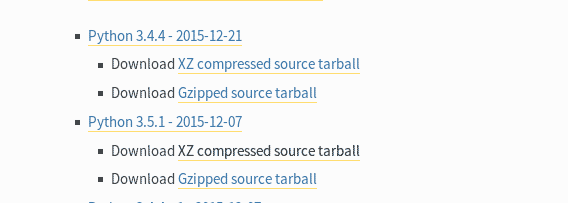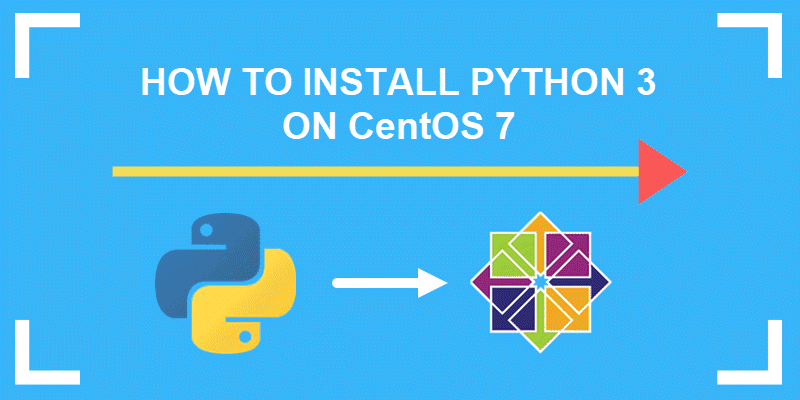This article covers how to install python2 and python3 on CentOS 8. By default, python2 and python3 are not installed on CentOS 8. To install both, you need to install all python packages separately according to python versions.
Also, you can run python2 and python3 environments on your system. The default python on CentOS/RHEL 7.x is python 2, StackStorm uses python3 and requires the python3-devel package. The installation of the st2 package will automatically install python3-devel if it is available in an enabled repository. On CentOS distributions the relevant repository is typically enabled however on RHEL distributions it is provided by the rhel-7-server-optional-rpms repository . Now enter into extracted directory and configure the source code files based on your system environment. Python is popular programming and versatile programming language.
It used to write small scripts, build games, develop websites, create machine learning algorithms, analyze data and more. In this tutorial, we will show you how to install python on CentOS 8 system. Assuming you have enabled the repository for Oracle Instant Client appropriate for your Oracle Linux release, it will be installed as a dependency. More details about Oracle Instant Client on this yum server.. Many times we end up with machine having older version of Python, especially CentOS. In this quick tutorial, we will see how to install python from source.
We are installing the latest Python version 3.8.3 here. Just make sure to update source link accordingly. By default, Python is not installed on CentOS 8, but this tutorial guides you through the installation process. The two most popular versions of Python are Python 2 and Python 3. Python 2 is an old version that will expire in 2020, and Python 3 is the latest version and is used in many applications. In the previous CentOS releases, an unversioned Python command was available by default, allowing users to easily set the default version of Python to their own preference.
However, CentOS 8/RHEL does not have an unversioned Python standard command anymore. This is because it prevents users from locking themselves to a particular version of Python. Therefore, CentOS 8 gives the user the choice to install and configure a particular version of Python according to their needs or install both versions side by side. Furthermore, you can download the packages for the latest LTS release build hereand nightly builds are also available herefor all the supported operating systems.
Please follow the instructions on the links to add rpm/deb repositories for the corresponding OS; grabbing the binary files directly does not give you all dependencies. The source files for LTS builds are available here and for nightly builds source files are here. You can download the packages for the latest feature release build herefor all the supported distributions. Please follow the instructions on that link to add rpm/deb repositories for the corresponding OS; grabbing the binary files directly does not give you all dependencies. To set up Python 3 on another computer, follow the local programming environment guides for Ubuntu 16.04, Debian 8, macOS, or Windows 10.
You can also read about installing Python and setting up a programming environment on an Ubuntu 16.04 server, which is especially useful when working on development teams. We will be using the open-source package manager tool DNF, which stands for Dandified YUM the next-generation version of the Yellowdog Updater, Modified . DNF is a package manager that is now the default package manager for Red Hat based Linux systems like CentOS. It will let you install, update, and remove software packages on your server. Instead of upgrading/replacing default python, we will install the new version of python using alternate install method.
This setup will also install corresponding pip for each python version separately. Before you move on to installing Python 3 on your CentOS system, make sure it is available in the package repository. If you have CentOS version 7.7 or newer, skip to the next step.
If you are using a CentOS release older than 7.7, you need to add IUS, a yum repository that provides newer software versions and includes Python 3. I believe in building on the work of others in the free software community. Why not take their rpm and make a few changes to differentiate my version from theirs to prevent any conflicts when installed? This is the path I chose and it was pretty successful. If you need a version of Python that is not supported through SCL, you can download a copy of the source code. This method requires additional software, plus extra steps to compile and install the Python package.
At first, we need to install necessary packages to build Python from the source code on CentOS 8. Run the following commands as root or user with sudo privileges. You need to be logged in as a non-root user with sudo privileges in order to follow along with this tutorial.
Open the terminal and execute the following commands to update the installed packages. Now the reason to build it from source is many times we need to have a specific python version .Hence we need to get that specific version and install it in our systems. Python 3.9.6 is the latest version available in the CentOS 8 repos. The EOL of Python 3.9.6 is Oct 2025, so you can use that version.
To install it, just run yum install python39 and that's it. If you want to install Python 3.10 or 3.11, follow the tutorial below. The virtual environment was not created successfully because ensurepip is not available. On Debian/Ubuntu systems, you need to install the python3-venv package using the following command.
Once all the packages are updated,we can go ahead and install python3 package through yum install command. To install the latest major release of Python, which is 3.9.6 , you need to download a copy of the source code and take some additional steps when setting up. Installation dependent environment # yum -y install zlib-devel bzip2-devel openssl-devel ncurses-devel sqlite-devel readline-devel tk-devel gdbm-devel db4-devel libpca... This process uses the apt package manager to install Python.
There are fewer steps, but it's dependent on third-party hosting software updates. You may not see new releases as quickly on a third-party repository. Tutorial How To Install Python 3.9 On CentOS 8 & Centos 7. One of the advantages of Python is that it can be used for most web design and other related tasks and does not impose any particular restrictions on the user.
This explanation was an introduction to the Python language so that we can teach you How To Install Python 3.9 On CentOS in the rest of this article. You can also see the packages available in Eldernode if you need to buy CentOS VPS server. Now check the latest installed python version using below command. Currently, at the time of writting this article, Python 3.8 is the latest major release of Python. This release includes many new features such as positional-only parameters, assignment expressions, runtime audit hooks, vectorcall, and more. Python 3.8 is not available in the standard CentOS 8 repositories.
On CentOS, you can install packages either with dnf or yum command. The Software Collection Library is intended for development environments which require access to the latest features of software components such as Perl, PHP, or Python. For these environments, it's important to minimize the disruption of system processes that rely on the versions of these components. The SCL enables you to install and use several versions of the same software on a system, simultaneously, and without disruption.
This tutorial series will guide you through installing Python 3 on your local machine and setting up a programming environment via the command line. The venv module will be used to set up a virtual environment for our development projects in the next step. We will be using the open-source package manager tool yum, which stands for Yellowdog Updater Modified.
This is a commonly used tool for working with software packages on Red Hat based Linux systems like CentOS. It will let you easily install and update, as well as remove software packages on your computer. This tutorial will guide you through installing Python 3 on your local CentOS 7 machine and setting up a programming environment via the command line. Now that we have our virtual environment set up, let's create the traditional "Hello, World!
This will make sure that our environment is working and gives us the opportunity to become more familiar with Python if we aren't already. Python is opensource, most widely used programming language across the globe. Python is platform independent high level programming language. It is developed by Guido van Rossum in 1989 and first released in 20th Feb 1991. In this article you will learn how to install Python 3.8 from source on your RHEL/CentOS 7 Linux machines. Use below set of commands to compile python source code on your system using altinstall.
Python download 2、Install the compilation environment required to compile Python3 source files 3. Miniconda allows you to create a minimal self contained Python installation, and then use theConda command to install additional packages. After installing required packages now download the the python using below command. The script downloads and installs the latest version of pip and another required package named setuptools.
This post describes how to install Python3.9 on CentOS along with the older versions of Python3. In this example we will install Python3.9 on the CentOS server which is having Python3.6 installed. By following below steps Python3.9 would be installed on the server without impacting existing installation. This video explains the method to install python 3.6 On CentOS 7.6 and also making python 3.6 as the default python version.
There are several ways to get started with Python development on Oracle Linux. The different Python versions available and the corresponding repository and RPM names are summarized in the tables below. So one of the best practices to run any Python based application is create a separate virtual environment for each of your application to manage its own dependencies. IN order to verify installation execute following command , your installation should return the latest python version that you have installed just now. In this tutorial, you learned about the installation of yum updates.
More we have explored how to install Python 2 and Python 3 on CentOS 8.0. Now, I'm sure you would be able to install any type of version of Python on the CentOS 8 system. Since instead we would like to install the most current upstream stable release of Python 3, we will need to install IUS, which stands for Inline with Upstream Stable.
A community project, IUS provides Red Hat Package Manager packages for some newer versions of select software. Python is a versatile programming language that can be used for many different programming projects. First published in 1991 with a name inspired by the British comedy group Monty Python, the development team wanted to make Python a language that was fun to use. Easy to set up, and written in a relatively straightforward style with immediate feedback on errors, Python is a great choice for beginners and experienced developers alike. Python 3 is the most current version of the language and is considered to be the future of Python.
Here, package_name can refer to any Python package or library, such as Django for web development or NumPy for scientific computing. So if you would like to install NumPy, you can do so with the command pip install numpy. This tutorial will guide you through installing Python 3 on a CentOS 8 cloud server and setting up a programming environment via the command line. Zeek can be downloaded as either pre-built binary packages for Linux, or in source code form. Solve the software required for Python compilation installation 2. If you already run a Hubot instance, you can install the hubot-stackstorm plugin and configure StackStorm environment variables, as described below.
Otherwise, the easiest way to enable StackStorm ChatOpsis to use the st2chatops package. All rpms are located in ~/rpmbuild/RPMS/x86_64 directory. Install them from the file system or even better copy them to a local repo to let other machines install from there as well.
See the contributing guide for complete instructions on building from the git source tree. Further, see creating a development environment if you wish to create a pandas development environment. Use this process to download and compile the source code from the developer. It's a bit more complicated, but the trade-off is accessing a newer release of Python. The altinstall command instructs your system to create a second installation of this version of Python. Without it, the system would replace the default version of Python.
Python is one of the most popular programming languages in the world. Python is a popular choice for beginners and experienced developers with simple and easy learning. Unlike other Linux distributions, Python does not install on CentOS 8 by default.
That's why we decided to teach you how to install Python 3.9 on CentOS 7 and CentOS 8 in this tutorial. Install Python 3.9 on it to do almost anything you want, write small scripts, build games, develop websites, create machine learning algorithms, analyze data, and more. Or if you are used to working with ouTube, DropBox, Reddit, Quora, Instagram, Pinterest it is a good idea to install Python because they all have been developed using Python.
Follow the below steps to install python 3.5 on CentOS/RHEL 6/7. Oracle Linux 8 offers several independently updated versions of Python via seperate modules. As Python is an integral part of the Oracle Linux operating system, each release comes with a Platform Python version. For Oracle Linux 7, the Platform Python is 2.7, and is always installed.



























